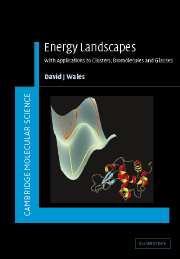Book contents
- Frontmatter
- Contents
- Preface
- 1 Introduction
- 2 The Born–Oppenheimer approximation and normal modes
- 3 Symmetry considerations
- 4 Features of the landscape
- 5 Describing the landscape
- 6 Exploring the landscape
- 7 Properties of the landscape
- 8 Clusters
- 9 Biomolecules
- 10 Glasses and supercooled liquids
- Appendix A Sylvester's law of inertia
- Appendix B Derivation of Ω(E, P, L)
- Index
1 - Introduction
Published online by Cambridge University Press: 05 October 2013
- Frontmatter
- Contents
- Preface
- 1 Introduction
- 2 The Born–Oppenheimer approximation and normal modes
- 3 Symmetry considerations
- 4 Features of the landscape
- 5 Describing the landscape
- 6 Exploring the landscape
- 7 Properties of the landscape
- 8 Clusters
- 9 Biomolecules
- 10 Glasses and supercooled liquids
- Appendix A Sylvester's law of inertia
- Appendix B Derivation of Ω(E, P, L)
- Index
Summary
The structure and dynamics of atomic and molecular clusters, the folding of proteins (1, 2), and the complicated phenomenology of glasses are all manifestations of the underlying potential energy surface (PES) (3). In each of these fields related ideas have emerged to explain and predict chemical and physical properties in terms of the PES. In studies of clusters and glasses the PES itself is often investigated directly, whereas for proteins and other biomolecules it is also common to define free energy surfaces, which are expressed in terms of a small number of order parameters. Here, typical order parameters include the number of hydrogen-bonds in the ‘native’ (folded) state, and structural quantities such as the radius of gyration.
The term ‘energy landscape’ was probably first introduced in the context of free energy surfaces (4–13). In particular, the surfaces obtained from models based on spin glass theory are discussed further in Sections 9.3 and 9.4. This approach is one aspect of ‘energy landscape theory’, but in this book a broader view is intended, which extends from the geometrical properties of potential energy surfaces to how these features determine the observed structural, dynamic and thermodynamic properties. Characterisation of a free energy surface often represents an important intermediate step in this analysis. The energy landscapes considered in subsequent chapters therefore include both potential energy and free energy surfaces.
- Type
- Chapter
- Information
- Energy LandscapesApplications to Clusters, Biomolecules and Glasses, pp. 1 - 118Publisher: Cambridge University PressPrint publication year: 2004

